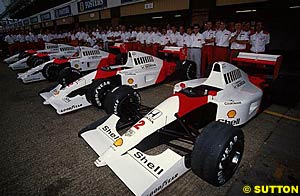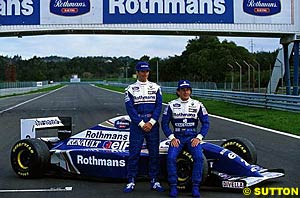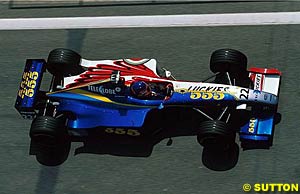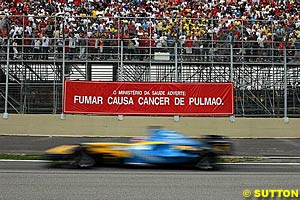
of F1's Tobacco Addiction
Atlas F1 Magazine Writer
By the end of the 2005 season, the Formula One grid will have the least number of tobacco-branded cars in decades. After 37 years, the sport is fighting the addiction as cigarette companies seek refuge in friendlier markets in the Far East and make the most of their borrowed time in the limelight. In the second and final part, Dieter Rencken analyses how tobacco became Formula One's liability and what happens after tobacco sponsorship will be eradicated
Evin did, though, provide a blueprint for others, and, in quick succession, its essence was adopted around Europe – but, at times, with rather strange legislative interpretations, and even weirder evasions.
The 1997 European Grand Prix at the Nurburgring, was, for example, renamed the Luxembourg Grand Prix despite being staged in Germany, and tobacco livery permitted; equally, at various times the Spa/Malmedy/Stavelot region was declared a duty-free area for the duration of certain Belgian Formula One events – simply because the country permitted tobacco advertising in duty-free zones.
The Nurburgring has seen other, rather more bizarre, solutions. Cars and race team personnel – i.e. those employed to physically work around and about the vehicles – were permitted full tobacco livery; those employed away from the pits (media, marketing, hospitality) were not. And, woe betides a race team member who snuck off without covering tobacco logos!
Italy, though, has, until very recently, been most creative. Although it originally banned all forms of direct and indirect tobacco advertising in 1962, it upped fines in the immediate wake of Evin, and again two years later. But, and herein lies the rub: fines remained negligible (by industry standards), and would-be transgressors merely budgeted for their imposition. Thus Ferrari, for example, was able to run throughout Italy in full Marlboro livery despite its home country having been amongst the first to introduce any form of tobacco control.
Exemptions were granted faster than governments passed anti-tobacco laws; thus Australia, which administers amongst the most draconian of tobacco laws, allows tobacco advertising from Grand Prix Thursday to Sunday, and only in Melbourne. As more traditional advertising avenues closed to tobacco brands, so they joined Formula One. Where once it had been Gunston and Gold Leaf on sixties grids, Lucky Strike, JPS and Marlboro joined in the early parts of the following decade. Barclay, Benson & Hedges, Camel, Chesterfield, Embassy, Gitanes/Gauloises (owned by the same government which introduced Evin...), Mild Seven and West variously made appearances, as did Rizla papers, Villiger cigars and Skoal Bandit oral tobacco.
Fortuitously (for Frank Williams and his outfit) Rothmans - which has enjoyed brief flirtations with Formula One back in the eighties with March, first via Ian Scheckter, then Jochen Mass - wanted back in and let it be known that approaches would be welcomed. Williams went all out, and bagged the brand in time for its first race with Ayrton Senna. Although the driver/partnership ended in tragedy, Rothmans was to enjoy success in 1996/7, having given best to Schumacher, Benetton and new arrival Mild Seven in 1995.
What marked out Rothmans' approach was not, however, that it had gone seeking a deal, but the weight of the publicity machine behind it. Marlboro had established a pretty slick publicity operation, having originally employed a pioneer of the industry who in turn recruited sponsorship maestro John Hogan, but Rothmans took the art to new heights. Even when a Rothmans Williams-Renault failed to win a Grand Prix, which occurred to them every second race on average, the weight of audio, visual and written material distributed by Rothmans International created perceptions of perpetual success.
Mission accomplished, Rothmans gave way to sister tobacco label Winfield, but, despite the first syllable in its name, the primarily Australian brand failed to do just that as Williams grappled with engine and driver issues, but parent British American Tobacco, which had absorbed Rothmans International in 1997, worried little about the ensuing two-year victory drought. It was preparing to fry bigger fish – the establishment of British American Racing in conjunction with Craig Pollock and reigning World Champion Jacques Villeneuve.
BAR has proven to be the most ambitious marketing programme in the history of the sport; possibly in the history of all sport. Tyrrell - whose non-tobacco 1969/1971/73 World Championships sandwiched the 1970/72 Gold Leaf/JPS championships of Lotus - was bought, the team's Surrey facility stripped out and a custom factory erected near Silverstone. Such were the expectations that BAR's directors suggested that BAR could well win its maiden Grand Prix.
All this, however, was overshadowed by the (in)famous 'Baccy Bung' issue which led to a grovelling apology from Tony Blair, after minutes of a meeting between the Prime Minister, FIA president Max Mosley, then-FIA vice president Bernie Ecclestone, FIA consultant David Ward, Blair's Chief of Staff Jonathan Powell, and Private Secretary. The last mentioned took handwritten notes and subsequently provided the following:
You asked for a typed version of my handwritten notes of the meeting with Max Mosley and Bernie Ecclestone. This follows:
The meeting raised no new issues of substance that had not previously been discussed between the FIA and Government and therefore no formal minute was made. However, for completeness and accuracy, the text below includes (in bold) my recollection of points made during the meeting, but not included in my handwritten notes. Of necessity, however, this is not an exhaustive account.
"HANDWRITTEN NOTES BY PRIVATE SECRETARY OF MEETING ON OCTOBER 16, 1997
Present:
MM: Proposals for EC Directive put forward by Luxembourg Presidency make no sense. If F1 leaves Europe, you will get more, not less sponsorship on TV. A perverse consequence. Subsidiarity suggested national legislation better anyway.
Great pressure for F1 to (move) to Far East. Ran through list of countries wanting a Grand Prix. Tobacco companies building circuits. Had been to see Tessa Jowell and Tony Banks. Not sure if we understood.
PM: Don't need persuading about basic case in favour of F1. But also in favour of a ban on tobacco ads. Asked why we were pursuing a directive, not national legislation?
PS: Because it is best way of getting ban quickly.
BE: FIA has made F1 every hi-tech. If tobacco money goes, lose this. He has put a lot of effort into developing TV. Digital technology coming. TV will go with the races.
PS: Can you not find alternative sponsors? eg car manufacturers.
BE: No. (They do not have the resources.)
PS: Did you realise Directive had four year phase-in. Would not come into effect for another two years, so six or so in all. (No response).
BE: Met Kohl (in Luxembourg) and Prodi. They agree with us that it is impractical Directive and will say so.
PM: Why do other countries not see the problem?
BE and DW: some of them do, which is why we cannot understand why they are arguing for the directive. Italy had ban in place, but it did not stop GP taking place. At beginning of GP weekend the organisers paid a fine of about 10,000 dollars and that was the end of it.
PS: Not unusual for Health Ministers in other countries to take hard stance on this.
DW: What about other sports? eg motorbikes.
PM: do other sports have the same scale of dependence? (general discussion: some did have tobacco sponsorship, but not on same scale)
PM: Thank you for coming in. Recognise the problems. We would think about what they had said."
The matter rapidly escalated, particularly when it became apparent that Ecclestone had, pre-1997 elections - which voted Labour under Blair into government, donated to the Party the sum of one million pounds. It had been, he explained subsequently, a tax-saving investment – Blair had promised to reduce taxes at the upper end of the structure, and, thus, Ecclestone reckoned, he would benefit from reduced taxes should Blair be elected. In any event, Labour reduced taxes at the top end of the scale, Blair faced the first major crisis of his leadership and returned the 'bung' to Bernie...
In effect the EU decree demands that no tobacco product may be advertised on European soil under any circumstances, and most countries interpreted that as a ban on the usage of tobacco livery on their soil, not to (i.e. via television or other media means) their soil. Great Britain, still smarting from the 'bung', has adopted the latter interpretation, and until clarity is received in a matter brought in the European Court by Germany (driven by the Nurburgring GmbH, which believes the ban on advertising of a legal product to be unconstitutional), no binding interpretation is expected from either Whitehall or Brussels.
In the interim, British tobacco-sponsored teams - BAR, McLaren, and Renault (which operates from a base in Oxfordshire) - live in fear of possible prosecution for contravening a hastily framed and ill-defined law. At BAR's launch, CEO Nick Fry was adamant that the team would continue with Lucky Strike branding, as their legal advice was that the intention of the law differed from Whitehall's interpretation, and stressed the need for clarity.
Until that point, Formula One's funding faces an uncertain future: yes, it is certain that tobacco sponsorship will go, but the timeframe is riddled with international uncertainties. Another certainty is that the governmental nannies will not stop with tobacco. In 1997, WHO published its 'hit-list' of product categories it was targeting the marketing of. First, and rapidly banned, was the marketing of breast milk substitutes, but this banning came and went without fanfare, for how many sports marketed the products?
Then came tobacco - and, as has been illustrated, it is only a (short term) matter before that comes to pass. Next up will come alcohol (as McLaren, phasing out West in favour of Johnnie Walker, is already discovering) then fast 'junk' foods, followed by sweets and confectionary. It is, however, the final product on the list that most alarms: 'power advertising', as WHO terms it.
Yes, the body is hoping, sooner rather than later, to ban any advertising promoting the thrills of speed and power – as youth may fall under its spell. So, should WHO get its way – and precedent suggests it could - BMW could not advertise that its V10 M5 runs to 250km/h, or hits 100 km/h in four seconds; Michelin could not suggest that its tyres are safe in wet weather. No prizes for guessing the long term effects of such decrees upon F1...
Tobacco sponsorship started in small, localised fashion in 1968, and 30 years later escalated into an issue with the potential to topple Blair, then confuse civilised governments. It started through the desperation of a handful of racers in a war-torn country to continue in Formula One, and escalated into a full-scale tobacco war as brands battled each other for marketing supremacy through on-track victory.
John Love, who was the first to sport tobacco livery, has no regrets, and the clock cannot be wound back; tobacco sponsorship contributed to the rich heritage of the sport, and for that we should be thankful. Smoking always was a matter of choice, and Formula One made its choices, but soon will no longer be in that position. The last non-tobacco World Champion was Nelson Piquet in 1983; who will be the next one?
On the tenth day of January 1991, France adopted a law restricting the marketing of tobacco (and, primarily, alcohol) products within its borders. The law had been piloted through parliament by the country's then-Health Minister, Claude Evin, and, as such, carried his name.
 Despite severe opposition by various factions, and accusations that Loi Evin was discriminatory and encroached upon various European Union decrees, including its 'Television Without Frontiers' directive, the law was enacted. Of course, tobacco advertising was immediately banned at, for example, Magny-Cours, which that year was hosting its inaugural Grand Prix, but, as the major tobacco sponsors had previously agreed to voluntarily restrict their liveries in France, the United Kingdom and Germany, Evin's direct impact in the country of its origin had little effect on Formula One.
Despite severe opposition by various factions, and accusations that Loi Evin was discriminatory and encroached upon various European Union decrees, including its 'Television Without Frontiers' directive, the law was enacted. Of course, tobacco advertising was immediately banned at, for example, Magny-Cours, which that year was hosting its inaugural Grand Prix, but, as the major tobacco sponsors had previously agreed to voluntarily restrict their liveries in France, the United Kingdom and Germany, Evin's direct impact in the country of its origin had little effect on Formula One.
 Localised brands, too, made appearances, but it was the arrival of Rothmans and, later, Lucky Strike/555, which signified a seismic shift in the industry's approach to the sport. Camel had been a partner of Williams - winning the 1992/3 World Championships via Nigel Mansell and Alain Prost respectively - but a scaling down of its involvement with the then Didcot-based team was on the cards for three reasons: first, a management buy-out of Camel parent RJ Reynolds was under discussion; second, the brand had only ever enjoyed secondary billing to Williams' title sponsor; and third, Camel support was spread over Williams and Benetton, and the latter had snapped up Michael Schumacher.
Localised brands, too, made appearances, but it was the arrival of Rothmans and, later, Lucky Strike/555, which signified a seismic shift in the industry's approach to the sport. Camel had been a partner of Williams - winning the 1992/3 World Championships via Nigel Mansell and Alain Prost respectively - but a scaling down of its involvement with the then Didcot-based team was on the cards for three reasons: first, a management buy-out of Camel parent RJ Reynolds was under discussion; second, the brand had only ever enjoyed secondary billing to Williams' title sponsor; and third, Camel support was spread over Williams and Benetton, and the latter had snapped up Michael Schumacher.
 History records that the team failed to score a single point in 1999, and did not do much better until last season, when they finished as first non-Ferrari car and driver. In excess of $1.5 billion (USD) has been spent thus far, yet BAT maintains steadfastly that its investment has paid massive dividends in marketing terms – despite a conspicuous absence of early on-track successes. Of course, it could be argued that, with few legal alternatives and the nature of the product, any form of tobacco marketing pays dividends, but the fact remains that BAT chose to go for broke by, effectively, creating its own sponsorship vehicle in its own image - vastly the more expensive option - rather than entering into a partnership with an existing team.
History records that the team failed to score a single point in 1999, and did not do much better until last season, when they finished as first non-Ferrari car and driver. In excess of $1.5 billion (USD) has been spent thus far, yet BAT maintains steadfastly that its investment has paid massive dividends in marketing terms – despite a conspicuous absence of early on-track successes. Of course, it could be argued that, with few legal alternatives and the nature of the product, any form of tobacco marketing pays dividends, but the fact remains that BAT chose to go for broke by, effectively, creating its own sponsorship vehicle in its own image - vastly the more expensive option - rather than entering into a partnership with an existing team.
Prime Minister
Prime Minister
Max Mosley
Bernie Ecclestone
David Ward
Jonathan Powell
Private Secretary
 In the interim, the European Union and World Health Organisation had been beavering away behind the scenes. WHO introduced its proposed Framework Convention on Tobacco Control which required a total ban on tobacco advertising on 31 December 2006, a date initially accepted by the EU and agreed to by the FIA. Then, for reasons best known to Brussels, the date was pulled forward to 31 July this year, and, in a flash, Formula One was thrown into disarray, for its tobacco partnerships were scheduled to run through to the original date.
In the interim, the European Union and World Health Organisation had been beavering away behind the scenes. WHO introduced its proposed Framework Convention on Tobacco Control which required a total ban on tobacco advertising on 31 December 2006, a date initially accepted by the EU and agreed to by the FIA. Then, for reasons best known to Brussels, the date was pulled forward to 31 July this year, and, in a flash, Formula One was thrown into disarray, for its tobacco partnerships were scheduled to run through to the original date.
|
Contact the Author Contact the Editor |
Please Contact Us for permission to republish this or any other material from Atlas F1.
|
Volume 11, Issue 8
2005 Season Preview
The Atlas F1 2005 Gamble
The 2005 Drivers Preview
The 2005 Teams Preview
The 2005 Technical Preview
Regular Columns & Articles
F1's Tobacco Addiction II
On the Road
Elsewhere in Racing
> Homepage |